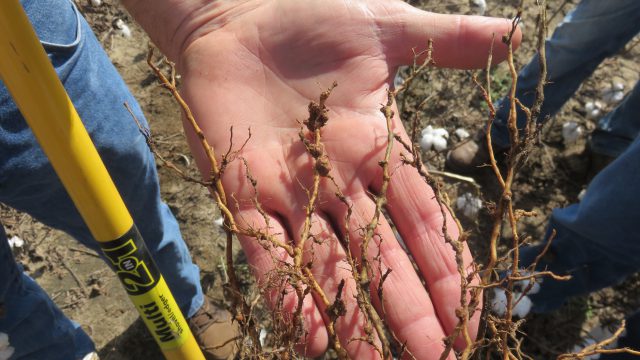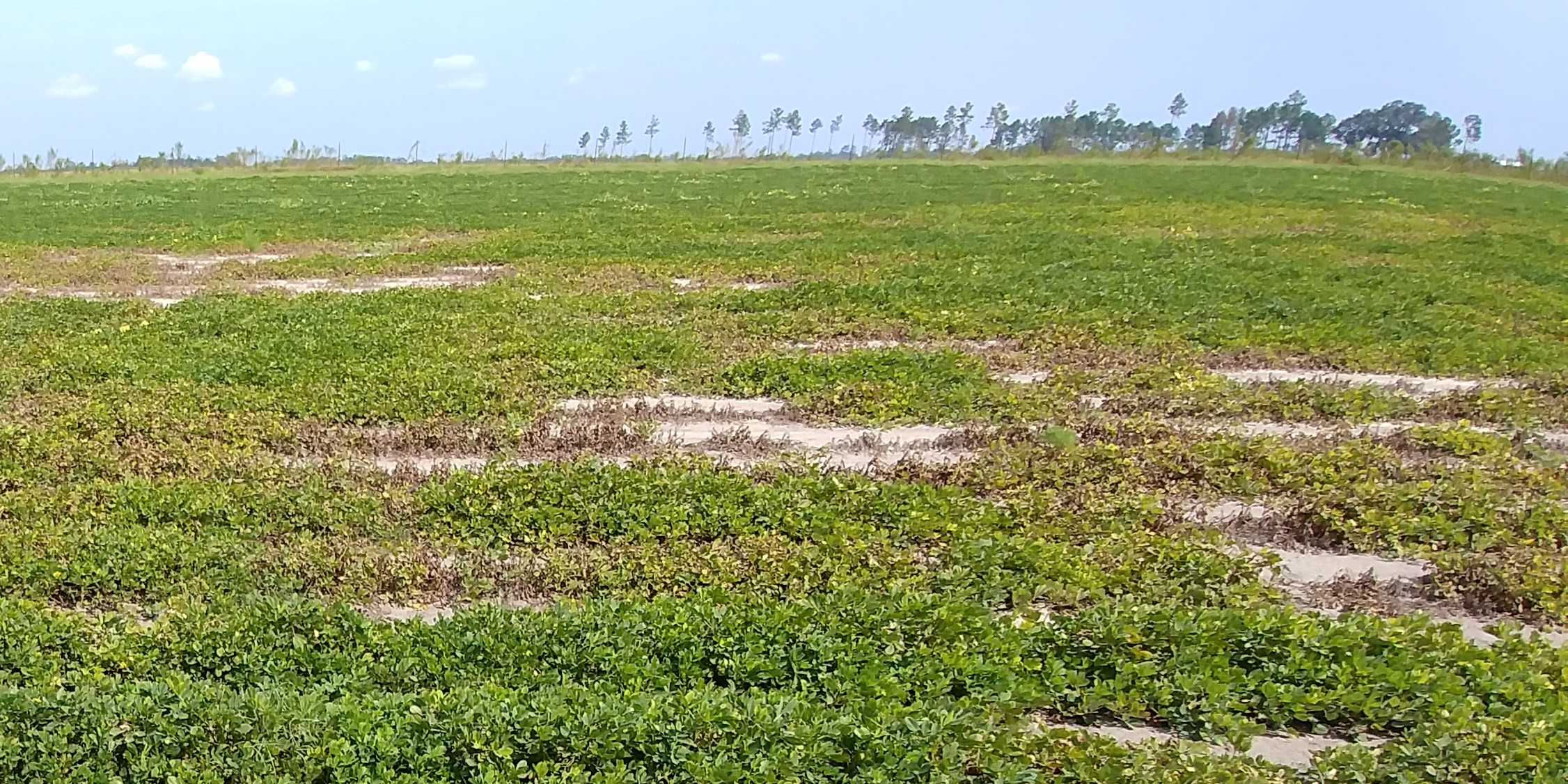
David Wright examines cotton roots damaged by nematodes in the Jackson County Cotton Variety Test in 2017. Credit: Doug Mayo
Zane Grabau, UF/IFAS Nematologist, and Ethan Carter, Regional Crop IPM Agent
Nematicide application, along with crop rotation and use of resistant cultivars, is a key tool for nematode management. To that end, the number of nematicides/insecticides available to Florida cotton and peanut growers will be increasing in 2018, as a few products are newly available or return from hiatus. The active ingredients in the nematicides aldicarb and oxamyl, were introduced a number of years ago, and will be familiar to growers. All products mentioned are restricted-use pesticides to be applied only by certified pesticide applicators and as instructed on product labels.
AgLogic 15G (corncob grit formulation) and AgLogic 15GG (gypsum formulation) are granular nematicides produced by AgLogic Chemical and have the active ingredient aldicarb. Aldicarb was the active ingredient in Temik, a granular product that many growers are familiar with but is no longer available. Being available in neighboring states the past two years, AgLogic 15GG is newly registered in Florida for the 2018 season, so growers can now buy and apply the product in Florida. The granular product is applied in-furrow at planting and may be followed by a post-emergence application before peanut pegging or cotton squaring. The post-emergence application must be side-dressed in an open furrow and immediately covered with soil. Maximum application rates are 7 lb/acre at planting for both crops, 5 lb/acre post-emergence for cotton, and 10 lb/acre post-emergence for peanut. Grazing restrictions are associated with this product, hay and vines cannot be fed to livestock. See label for mandatory minimum distances between the nearest well and aldicarb application, as these distances vary based on soil type and well casing. Research trials comparing AgLogic and other nematicides in cotton and peanut have been conducted by the University of Florida in 2017. The results of these trials will be disseminated at upcoming Extension events and in upcoming articles. Early results suggest AgLogic performed similarly to other available nematicides.

Patches of dead peanuts in the Suwannee Valley due to root-knot nematode infection. Credit: Zane Grabau
Following a few years hiatus, two products, Vydate CL-V by Dupont and ReTurn XL, by Rotam and distributed by AMVAC, with the active ingredient oxamyl will be available for the 2018 growing season. Both products are liquid formulations that can be sprayed at or before planting and incorporated into the soil. They can also be applied up to 4 times after crop emergence as a foliar spray. Reducing nematode populations before plants emerge is critical for nematicides to be effective, so oxamyl foliar sprays need to be combined with an at-plant or pre-plant nematicide application. Both products are labelled for cotton and peanuts as well as a number of fruit and vegetable crops.
In addition to AgLogic, Vydate CL-V, and ReTurn XL, nematicides labelled for use on peanuts and cotton include 1,3-Dichloropropene (Telone II by Dow and similar products), fluopyram (Velum Total by Bayer), metam sodium (Vapam by AMVAC and similar products), and metam potassium (K-pam by AMVAC and similar products). Checking for nematode infestation prior to applying a nematicide can help determine if nematicide application is necessary.
Summary
- Nematicides with the active ingredients aldicarb and oxamyl will be available in 2018, after a hiatus for a number of years.
- Always read and follow label instructions when applying pesticides.
This article is for informational purposes and is not a substitute for reading label instructions or consulting state rules and regulations. Mention of a specific product does not imply endorsement. For more information on nematode management in cotton see the EDIS article below and look for the upcoming peanut nematode management guide.
Cotton Nematode Management Guide
- Salibro: A Recently-Registered Conventional Nematicide for Select Horticulture Crops - March 7, 2025
- What Cotton Cultivars have Resistance or Tolerance to Southern Root-knot and Reniform Nematode? - February 28, 2025
- How Well Do Root-Knot Nematode Resistant Peanut Cultivars Perform in Florida? - February 14, 2025
